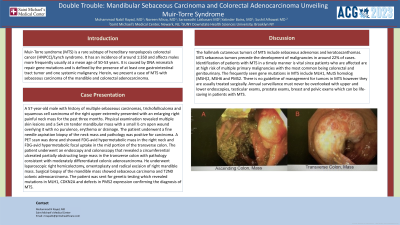Tuesday Poster Session
Category: Colon
P3136 - Double Trouble: Mandibular Sebaceous Carcinoma and Colorectal Adenocarcinoma Unveiling Muir-Torre Syndrome
Tuesday, October 24, 2023
10:30 AM - 4:00 PM PT
Location: Exhibit Hall

Has Audio

Mohammad Nabil Rayad, MD
Saint Michael's Medical Center, New York Medical College
Newark, New Jersey
Presenting Author(s)
Mohammad Nabil Rayad, MD1, Noreen Mirza, MD1, Saraswathi Lakkasani, MD1, Yatinder Bains, MD1, Sushil Ahlawat, MD2
1Saint Michael's Medical Center, New York Medical College, Newark, NJ; 2SUNY Downstate Health Sciences University, Brooklyn, NY
Introduction: Muir-Torre syndrome (MTS) is a rare subtype of hereditary nonpolyposis colorectal cancer (HNPCC)/Lynch syndrome. It has an incidence of around 1:350 and affects males more frequently usually at a mean age of 50-53 years. It is caused by DNA mismatch repair gene mutations and is defined by the presence of at least one gastrointestinal tract tumor and one systemic malignancy. Herein, we present a case of MTS with sebaceous carcinoma of the mandible and colorectal adenocarcinoma.
Case Description/Methods: A 57-year-old male with history of multiple sebaceous carcinomas, trichofolliculoma and squamous cell carcinoma of the right upper extremity presented with an enlarging right painful neck mass for the past three months. Physical examination revealed multiple skin lesions and a 5x4 cm tender mandibular mass with a small ½ cm open wound overlying it with no purulence, erythema or drainage. The patient underwent a fine needle aspiration biopsy of the neck mass and pathology was positive for carcinoma. A PET scan was done and showed FDG-avid hypermetabolic mass in the right neck and FDG-avid hypermetabolic focal uptake in the mid portion of the transverse colon. The patient underwent an endoscopy and colonoscopy that revealed a circumferential ulcerated partially obstructing large mass in the transverse colon with pathology consistent with moderately differentiated colonic adenocarcinoma. He underwent laparoscopic right hemicolectomy, omentoplasty and radical excision of right mandible mass. Surgical biopsy of the mandible mass showed sebaceous carcinoma and T2N0 colonic adenocarcinoma. The patient was sent for genetic testing which revealed mutations in MLH1, CDKN2A and defects in PMS2 expression confirming the diagnosis of MTS.
Discussion: The hallmark cutaneous tumors of MTS include sebaceous adenomas and keratoacanthomas. MTS sebaceous tumors precede the development of malignancies in around 22% of cases. Identification of patients with MTS in a timely manner is vital since patients who are affected are at high risk of multiple primary malignancies with the most common being colorectal and genitourinary. The frequently seen gene mutations in MTS include MLH1, MutS homolog (MSH)2, MSH6 and PMS2. There is no guideline of management for tumors in MTS however they are usually treated surgically. Annual surveillance must never be overlooked with upper and lower endoscopies, testicular exams, prostate exams, breast and pelvic exams which can be life-saving in patients with MTS.

Disclosures:
Mohammad Nabil Rayad, MD1, Noreen Mirza, MD1, Saraswathi Lakkasani, MD1, Yatinder Bains, MD1, Sushil Ahlawat, MD2. P3136 - Double Trouble: Mandibular Sebaceous Carcinoma and Colorectal Adenocarcinoma Unveiling Muir-Torre Syndrome, ACG 2023 Annual Scientific Meeting Abstracts. Vancouver, BC, Canada: American College of Gastroenterology.
1Saint Michael's Medical Center, New York Medical College, Newark, NJ; 2SUNY Downstate Health Sciences University, Brooklyn, NY
Introduction: Muir-Torre syndrome (MTS) is a rare subtype of hereditary nonpolyposis colorectal cancer (HNPCC)/Lynch syndrome. It has an incidence of around 1:350 and affects males more frequently usually at a mean age of 50-53 years. It is caused by DNA mismatch repair gene mutations and is defined by the presence of at least one gastrointestinal tract tumor and one systemic malignancy. Herein, we present a case of MTS with sebaceous carcinoma of the mandible and colorectal adenocarcinoma.
Case Description/Methods: A 57-year-old male with history of multiple sebaceous carcinomas, trichofolliculoma and squamous cell carcinoma of the right upper extremity presented with an enlarging right painful neck mass for the past three months. Physical examination revealed multiple skin lesions and a 5x4 cm tender mandibular mass with a small ½ cm open wound overlying it with no purulence, erythema or drainage. The patient underwent a fine needle aspiration biopsy of the neck mass and pathology was positive for carcinoma. A PET scan was done and showed FDG-avid hypermetabolic mass in the right neck and FDG-avid hypermetabolic focal uptake in the mid portion of the transverse colon. The patient underwent an endoscopy and colonoscopy that revealed a circumferential ulcerated partially obstructing large mass in the transverse colon with pathology consistent with moderately differentiated colonic adenocarcinoma. He underwent laparoscopic right hemicolectomy, omentoplasty and radical excision of right mandible mass. Surgical biopsy of the mandible mass showed sebaceous carcinoma and T2N0 colonic adenocarcinoma. The patient was sent for genetic testing which revealed mutations in MLH1, CDKN2A and defects in PMS2 expression confirming the diagnosis of MTS.
Discussion: The hallmark cutaneous tumors of MTS include sebaceous adenomas and keratoacanthomas. MTS sebaceous tumors precede the development of malignancies in around 22% of cases. Identification of patients with MTS in a timely manner is vital since patients who are affected are at high risk of multiple primary malignancies with the most common being colorectal and genitourinary. The frequently seen gene mutations in MTS include MLH1, MutS homolog (MSH)2, MSH6 and PMS2. There is no guideline of management for tumors in MTS however they are usually treated surgically. Annual surveillance must never be overlooked with upper and lower endoscopies, testicular exams, prostate exams, breast and pelvic exams which can be life-saving in patients with MTS.

Figure: A= Ascending colon mass
B= Transverse colon mass
B= Transverse colon mass
Disclosures:
Mohammad Nabil Rayad indicated no relevant financial relationships.
Noreen Mirza indicated no relevant financial relationships.
Saraswathi Lakkasani indicated no relevant financial relationships.
Yatinder Bains indicated no relevant financial relationships.
Sushil Ahlawat indicated no relevant financial relationships.
Mohammad Nabil Rayad, MD1, Noreen Mirza, MD1, Saraswathi Lakkasani, MD1, Yatinder Bains, MD1, Sushil Ahlawat, MD2. P3136 - Double Trouble: Mandibular Sebaceous Carcinoma and Colorectal Adenocarcinoma Unveiling Muir-Torre Syndrome, ACG 2023 Annual Scientific Meeting Abstracts. Vancouver, BC, Canada: American College of Gastroenterology.
